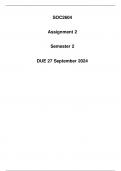SOC2604
Assignment 2
Semester 2
DUE 27 September 2024
, Theoretical Models of Disability: A Critical Examination
Disability is a multifaceted concept that encompasses various physical, cognitive, and
mental impairments. Over the years, different theoretical models have emerged to
explain the experiences of people with disabilities, influencing societal perceptions and
policy approaches. The most notable models include the Medical Model, Social Model,
and the Affirmation Model, each offering unique insights and implications for the lived
experiences of individuals with disabilities. In particular, the deaf community serves as a
prime example of a marginalized identity shaped by these varying theoretical
perspectives.
The Medical Model
Historically, the Medical Model has dominated the understanding of disability, viewin g it
primarily as a deficiency or limitation that resides within the individual. This model posits
that disability is synonymous with medical impairment, warranting treatment and
intervention (Oliver, 1990). Individuals identified as "disabled" are perceived as needing
"fixing" to restore them to a state of normalcy. This perspective often leads to
categorization that emphasizes deficits rather than capabilities.
However, the Medical Model has been criticized for pathologizing disability and ignoring
the social factors that influence the experiences of disabled individuals (Finkelstein,
1980). For the deaf community, this model might frame deafness as a condition
requiring remediation, reinforcing the idea that hearing is superior and that deaf
individuals should strive to "overcome" their disability through technology, such as
cochlear implants or hearing aids.
The Social Model
In contrast, the Social Model emerged to challenge the reductionist views of the Medical
Model by positioning disability as a socially constructed phenomenon. This model posits
that individuals become disabled not merely because of their impairments, but through
the interaction between their bodies and a society that is unaccommodating (Oliver,
1996). The Social Model asserts that systemic barriers—physical, attitudinal, and
institutional—play a significant role in disabling individuals.
For the deaf community, the Social Model underscores the importance of recognizing
deafness as a distinct cultural and linguistic identity. The use of sign language and the
rich cultural heritage of the deaf community are often sidelined within the Medical Model.
By adopting the Social Model approach, the deaf community can assert its autonomy,
emphasizing that it is not the deafness that is disabling, but society's failure to provide
equitable access and inclusion.




